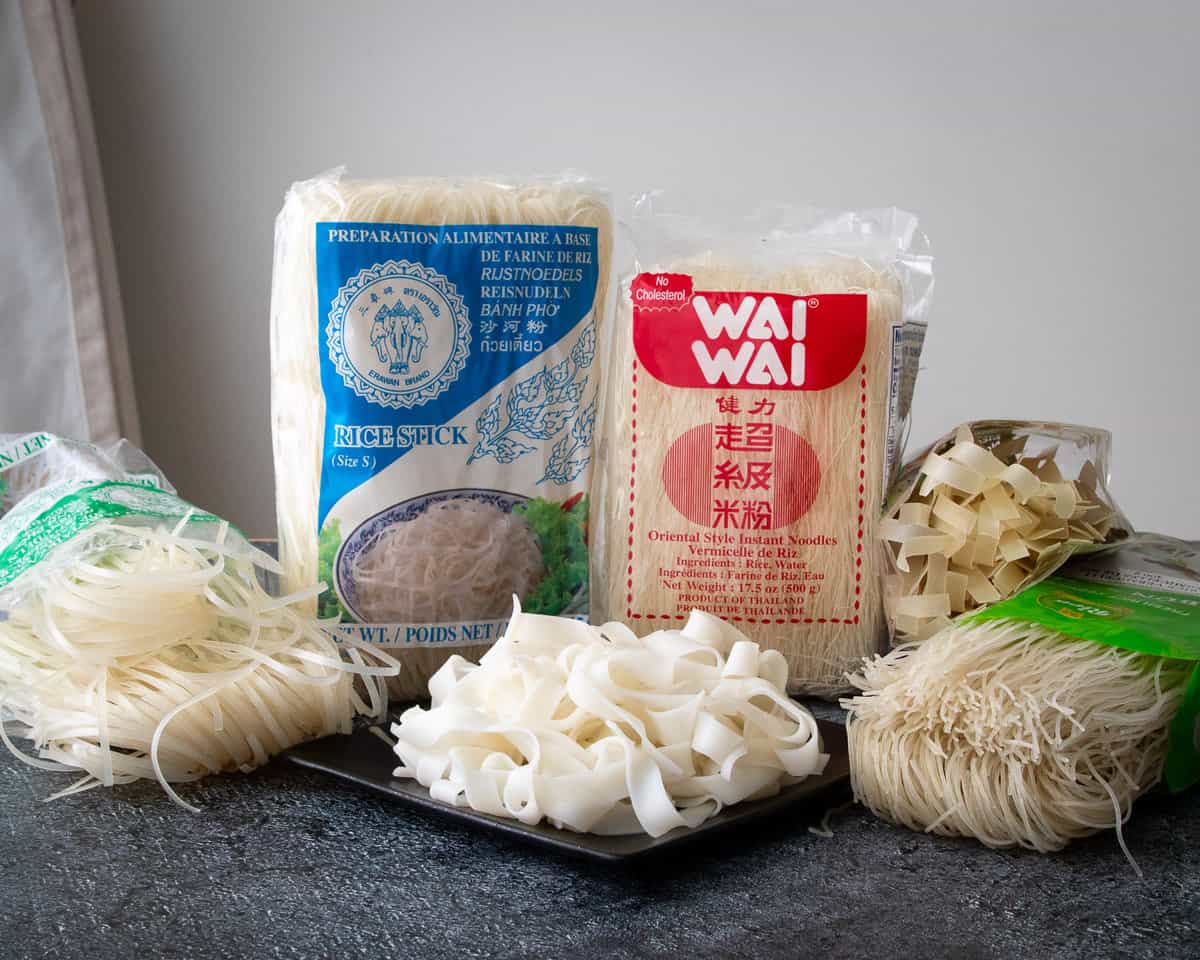
Maybe this has happened to you, you try to cook pad thai, and the noodles are soggy and clumpy. Or you try to cook pad see ew using fresh rice noodles, and they end up broken into bits. Or at the Asian supermarket your eyes glaze over at all the noodle options because you have no idea what to choose. Sounds familiar?
In this post I’m going to give you everything you need to know about all the different kinds of rice noodles used in Thai cooking, including how to cook them properly so you'll have perfectly cooked noodles every time.

Jump to:
Everything discussed in this article is covered in this explainer video below. It really helps to see in action how to properly cook rice noodles!
When it comes to dried rice noodles, the various types are all made from the same two ingredients: rice flour and water. Fresh rice noodles, however, have other starches and additives mixed in to make them sturdier and last longer.
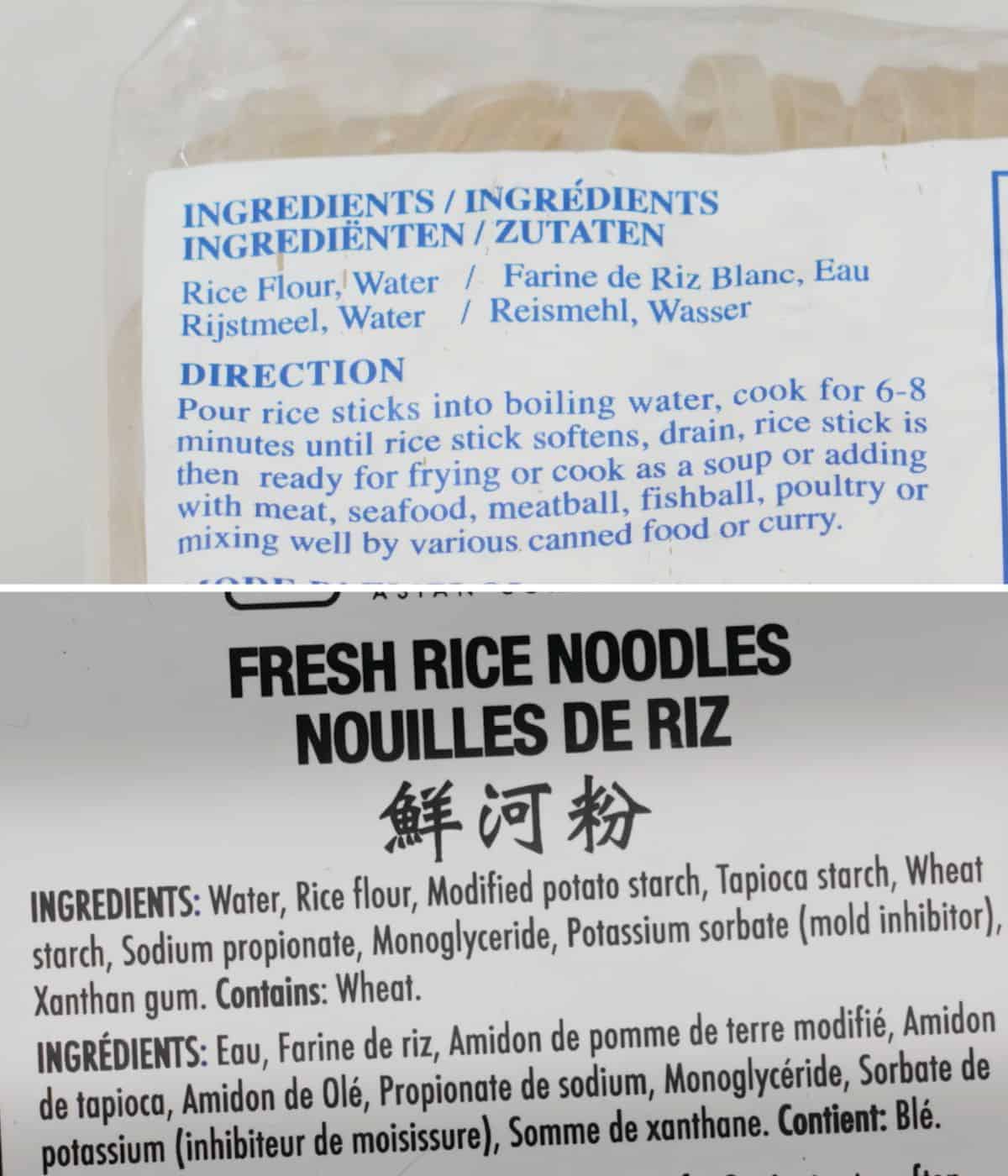
Unlike pasta or wheat noodles, rice noodles are gluten free and are not chewy. They are quite tender, which also makes them harder to work with because they can go from cooked to mush much more quickly. (Al dente is not a thing we aim for in rice noodles; that's just called undercooked 😂.)
Despite the many options at the store, rice noodles can be divided simply into two major categories: Fresh and dry.
Dry rice noodles are made from ground up rice (a.k.a. rice flour) and water. The mixture can be steamed into a big sheet, dried, and cut into "rice sticks," or they can be extruded into round noodles. To see a Thai rice noodle factory in action, check out my short documentary here!
As there are different types of pasta, there different types of dry rice noodles:



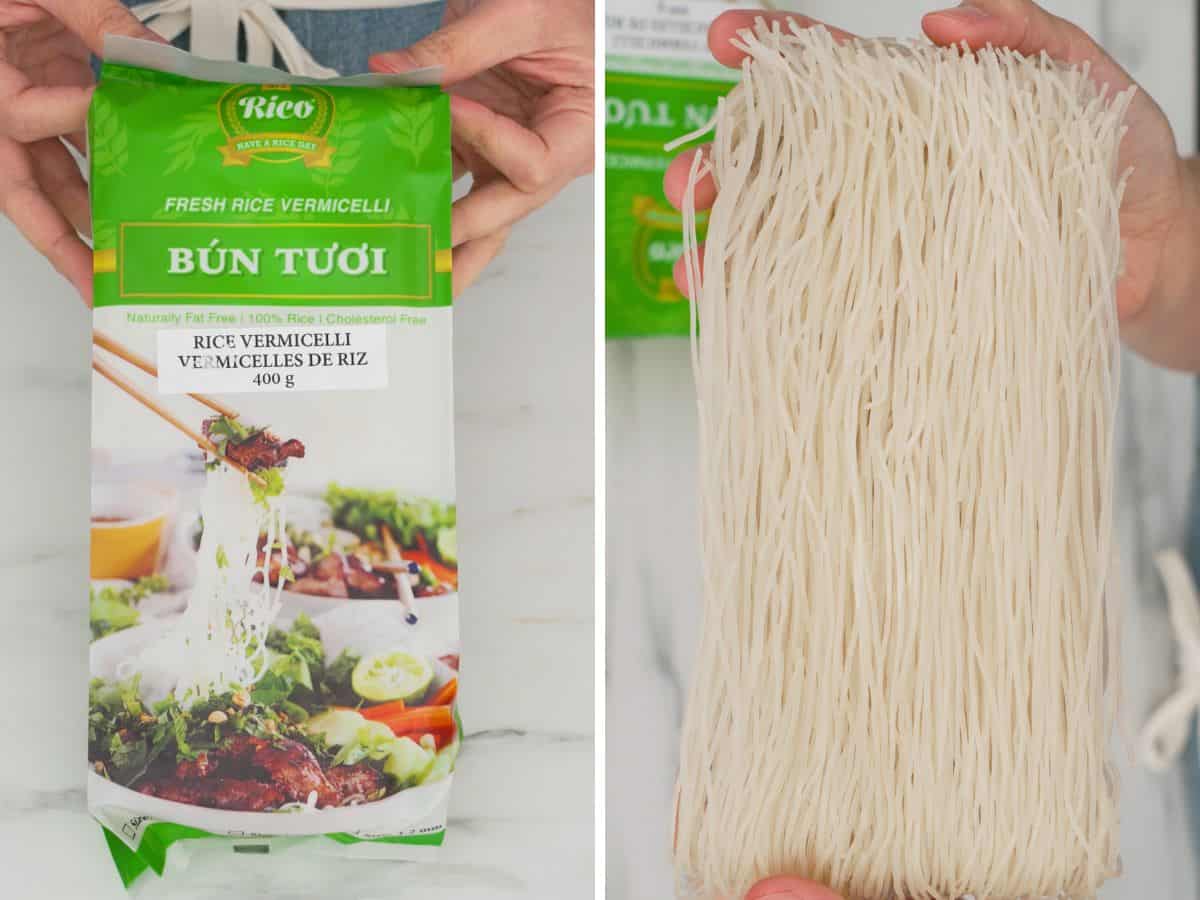
*Glass noodles, bean threads, or cellophane noodles are often misunderstood to be a type of rice noodles. The Thai/Chinese ones are actually made from mung bean starch, and the Korean ones are made from sweet potato starch.
Fresh rice noodles are found in the refrigerated section at Asian grocery stores, usually next to all the tofu. There are two main types:
These are the tender noodles with a slightly chewy texture that has gained a cult following for dishes like pad see ew. In Cantonese these are called “ho fun”. They are made mostly from rice flour but often have other starched such as tapioca starch mixed in.
This is a fresh, fully-cooked product that simply needs to be tossed with seasonings, meat and veggies. It's highly perishable which means they are usually made locally, so what you get from city to city is going to vary a lot in size and texture.
These can actually be made at home, check out my video tutorial for making your own fresh rice noodles!
Preparing Fresh Rice Noodles for Cooking:
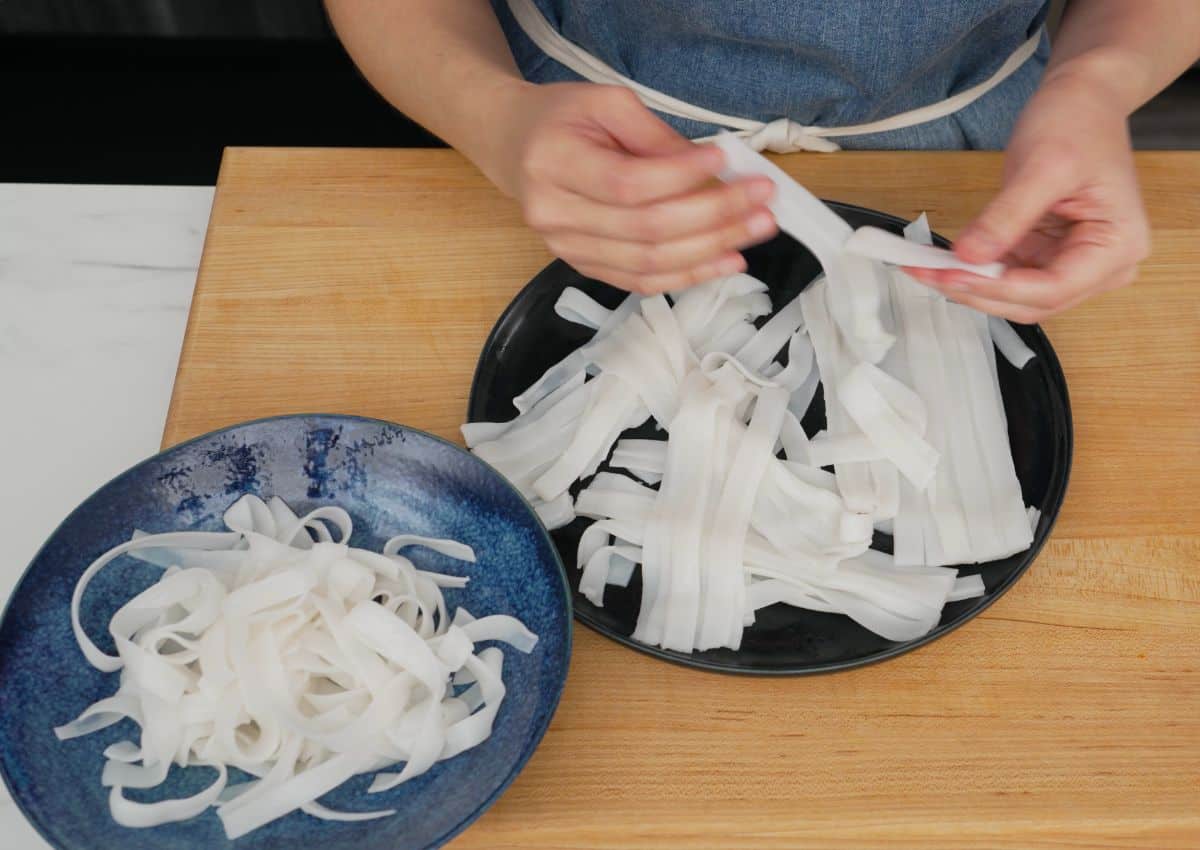
Before cooking them, you’ll want to peel apart the noodles. But cold noodles are often stuck together and are impossible to peel apart without breaking. If that's the case, separate them into chunks best you can, spread them out on a plate and microwave them for about a minute.
Take them out, see if any noodles are hot and soft enough to be peeled apart and peel them and set them aside. Return the hard noodles into the microwave for another minute, and repeat this until all the noodles can be separated. It usually takes me 3-4 minutes of microwaving for 1 lb of noodles.
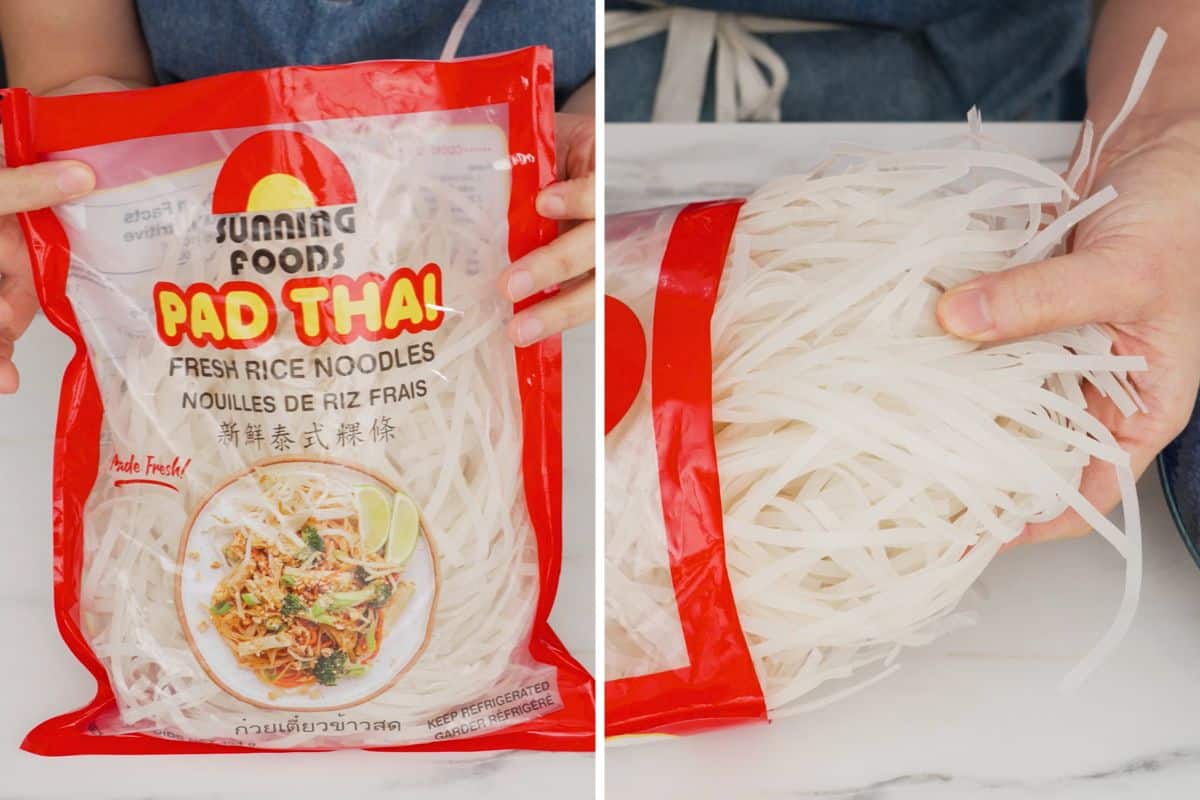
You may also see vacuum packed bags of rice noodles in the fridge that look very similar to the dried noodles. You can think of these as semi-dried version of the Small and Medium size dried noodles above. This type of noodles is what most restaurants use because they do not need to be rehydrated before using.
For noodle soups you want to go small. Anything from the vermicelli to the medium size is fine. This is because rice noodles have no flavour whatsoever, so all the flavour will comes from the broth. With small noodles there’s a lot of surface area for the broth to cling to. If you go too big, in each mouthful it’s going to feel like too much bland noodles and not enough broth flavour.
Fresh wide noodles (ho fun noodles) are the exception because fresh noodles are more tender and are less dense than the dried version, they can work fine in soups IF they’re not made too thick.
In Thailand, we actually have two types of fresh wide noodles: One for soups, which is thinner and more delicate, and one for stir fries, which are thicker and sturdier so they’re less likely to break in the wok!
The good news is that any of these are good for stir fries and it really comes down to your preference for which type of texture.
Cooking rice noodles is not actually hard, but most people misunderstand how they need to be treated.The #1 reason why your rice noodle stir fries are a soggy mess is that you’re cooking them before cooking them.
What I mean is that people often boil the noodles and cook them to perfection, and THEN they put them into the pan. But when you stir fry, there is a lot of liquid that comes from sauce, the meat, and the veggies. It doesn’t take much for rice noodles to over cook, so if they go into the pan already cooked, then they’ll very likely end up overcooked by the end.
Note that this isn’t an issue with egg noodles because they don’t overcook nearly as quickly, and in fact, you want egg noodles to be fully cooked before you stir fry them.
All dried noodles simply need to be soaked until fully rehydrated before being stir fried or blanched for noodle soups.
The reason we want to soak rather than boil is because rice noodles overcook very easily. Soaking allows the noodles to hydrate evenly, and then the heat from the pan is cooking the noodles using the water that’s already IN the noodles. This results in even cooking inside out, and a very low chance of over cooking.
Soak them in room temperature water using the following timing as a guide, keeping in mind that they vary between brands.
Pick the noodles up and they should droop completely, not resisting gravity. If they’re still trying to hold their original shape, they’re not ready.
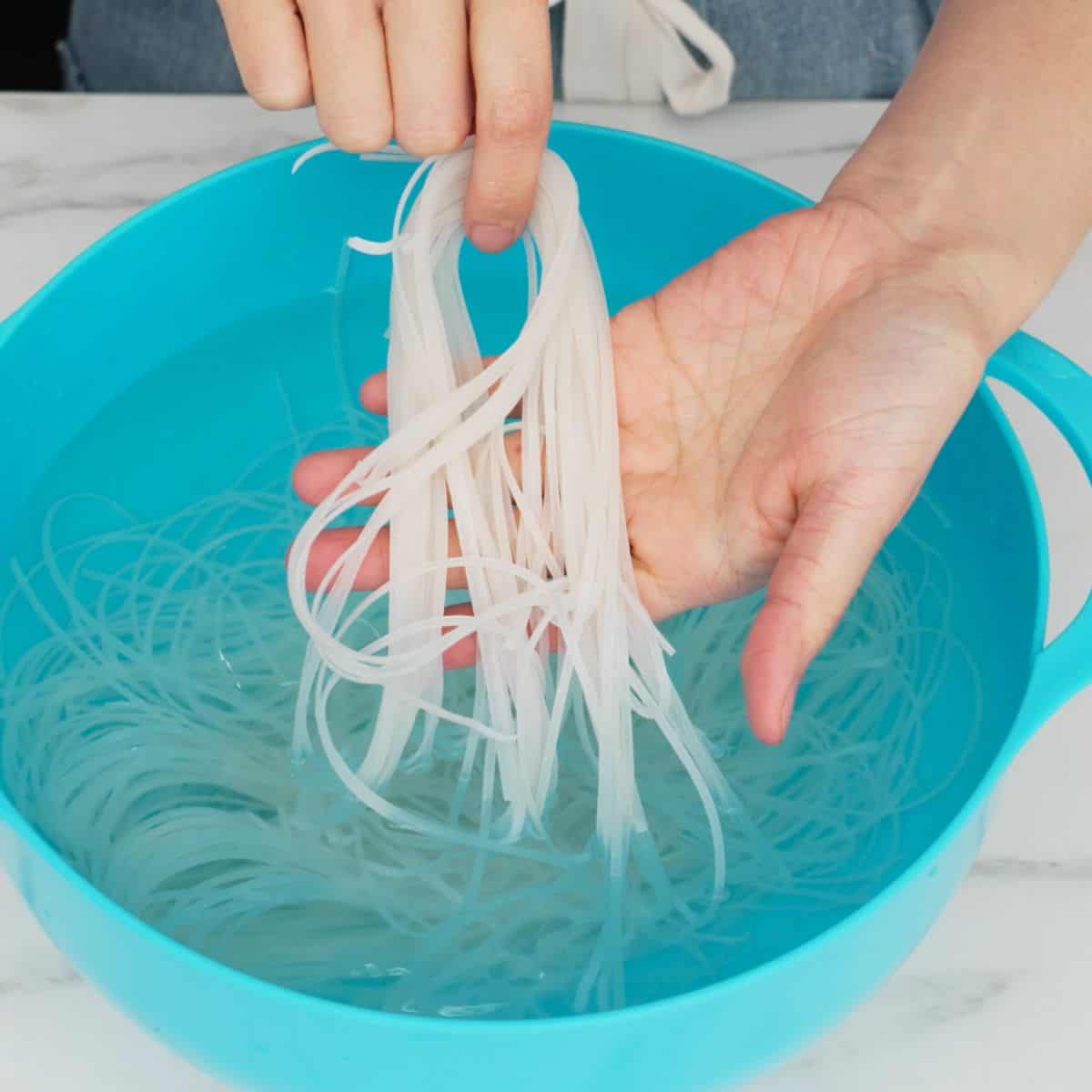
Once soaked, noodles are ready to go into the pan. Generally they will need a little extra liquid, but how much depends on how much liquid is already in the sauce, how crowded your pan is, how high your heat is, etc.
So I recommend following a trusted recipe amounts before winging it so you add the right amount of liquid for the dish. And when in doubt, add less water, then taste and add more as needed.
Noodles break because your spatula cut them into bits while you're stirring. Once you add noodles into the pan, especially delicate fresh cooked rice noodles, don't use a spatula and haphazardly stir them which can cause the edge of the spatula to cut the noodles. Use a flipping motion or push the noodles from the edges inward. Watch my video demo to see this technique in action!
Metal wok spatulas are like blades to these noodles, and they can easily chop your noodles without you realizing it!
Whatever pan of your choice, the surface should be nonstick because rice noodles, especially fresh ones, are notorious for sticking. And if you’re having to scrape them off, that’s one sure way to get broken noodles.
Crowding the pan is all sorts of bad news, but when it comes to noodles, this is likely the most common reason people end up with soggy and mushy noodles. Crowding traps moisture, and this moisture steams the noodles and you're basically boiling them, which causes the noodles to overcook. Overcooked noodles are too soft. too soft noodles break into bits.
This is why I stress so much that you should only cook pad thai in batches of 2 servings, and the most delicate fresh noodles should be cooked ONE portion at a time. There is a reason why street vendors cook them one order at a time!
On a related note, you should always use high heat when stir frying noodles to maximize liquid evaporation and prevent excess moisture in the pan.
While stir fried noodles get a little extra liquid from the stir fry sauce, noodles for soups are going to be sitting in a bowl of hot broth. This means that they should go into the bowls still a little al dente, and the heat of the broth will cook them through.
To get al dente noodles, blanch them in boiling water for just a few seconds: rice vermicelli noodles take 3 seconds, size small take 5 seconds, and size medium take 8 seconds. Cooking time will vary between brands.
I use room temperature water as a default because it takes so long for them to over soak that I don’t even have to set a timer. But if you're short on time, warm water will make the soaking go faster. However, the warmer the water, the faster they over-soak, which results in too-soft noodles, so check them often.
If you totally forgot to soak but need the noodles NOW, there is an emergency solution. Use hot water, and I mean off-the-boil, and soak the large size for 4 minutes, the medium size for 3 minutes, and the small size for 2, and immediately drain and rinse them in cold water to stop the cooking. I wouldn’t risk this method with the vermicelli, but they don’t take long anyway.
Not saying they’re always wrong, but they often are. The package instructions on Erawan brand noodles for sizes S, M and L all tell you to boil them for 6-8 minutes. You can probably guess that different sizes of noodles should not have the same cooking time! And I’ve seen many other Asian products with instructions that just don’t work, so I never assume they’re right.
If you can plan ahead, soak the noodles, drain them, and keep them in an airtight container in the fridge. Make sure there is no pooling water in the container which will over soak the noodles at the bottom. I recommend putting them on a tea towel before storing them to dab off excess water. Soaked noodles will last in the fridge for up to 1 week.
Now that you know everything there is to know about rice noodles, you're ready to get cooking! Try one of these popular classics!